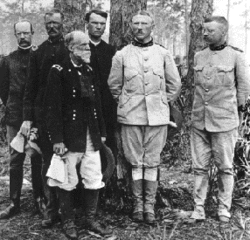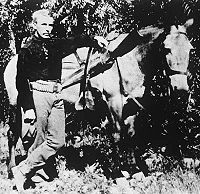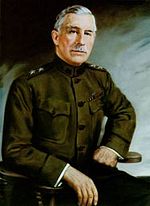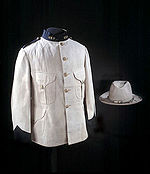Leonard Wood - Picture
More about World War 1

|
|
Leonard Wood
Place of birth: Winchester, New Hampshire
Place of death: Boston, Massachusetts
Place of burial: Arlington National Cemetery
Allegiance: United States of America
Service/branch: United States Army
Years of service: 1885-1921
Rank: Major General
Commands held: Chief of Staff of the United States Army
Battles/wars: Spanish-American War
Philippine-American War
Awards: Medal of Honor
Other work: Governor General of Cuba
Leonard Wood (October 9, 1860 - August 7, 1927) was a physician who served as the Chief of Staff of the United States Army, Military Governor of Cuba and Governor General of the Philippines. Early in his military career, he received the Medal of Honor. Wood also holds officer service #2 in the Regular Army (John Pershing holds officer service #1). He was responsible for the 1906 Moro Crater massacre.
Biography
Early life and career
Born in Winchester, New Hampshire, he attended Pierce Academy in Middleborough, Massachusetts, and Harvard Medical School, earning an M.D. degree in 1884 as an intern at Boston City Hospital.
He took a position as an Army contract physician in 1885, and was stationed at Fort Huachuca, Arizona. Wood participated in the last campaign against Geronimo in 1886, and was awarded the Medal of Honor, in 1898, for carrying dispatches 100 miles through hostile territory and for commanding an infantry detachment whose officers had been lost.
While stationed at Fort McPherson in Atlanta, Georgia in 1893, Wood enrolled in graduate school at Georgia Tech, then known as the Georgia School of Technology, and became the school's second football coach and, as a player, its team captain. Wood led the team to its first ever football victory, 28 to 6, over the University of Georgia.
Spanish-American War
Wood was personal physician to Presidents Grover Cleveland and William McKinley through 1898. It was during this period he developed a friendship with Theodore Roosevelt, then Assistant Secretary of the Navy. At the outbreak of the Spanish-American War, Wood, with Roosevelt, organized the 1st Volunteer Cavalry regiment, popularly known as the Rough Riders. Wood commanded the regiment in a successful engagement known as the Battle of Las Guasimas. When brigade commander, Samuel B. M. Young became ill, Wood received a field promotion to brigadier general of volunteers and assumed command of the 2nd Brigade, Cavalry Division, V Corps (which included the Rough Riders) and led the brigade to a famous victory at Kettle Hill and San Juan Heights.

Picture - Staff of the 1st US Volunteer Regiment, the "Rough Riders" in Tampa - Wood is 2nd from right with LtCol Roosevelt far right.
After San Juan, Wood led the 2nd Cavalry Brigade for the rest of the war; he stayed in Cuba after the war and was appointed the Military Governor of Santiago in 1898, and of Cuba from 1899-1902. In that capacity, he relied on his medical experience to institute improvements to the medical and sanitary conditions in Cuba. He also ordered the incarceration of Dr. Manuel M. Coronado, director of La Discusix³n newspaper and Jesus Castellanos, caricaturist of the newspaper because Jesus Castellanos drew a cartoon that was published on April 12, 1901, in the Cuban paper La Discusix³n. The cartoon showed "The Cuban People" represented by a crucified Jesus Christ between two thieves, General Wood and American President William McKinley. Cuban public opinion was depicted by Mary Magdalene on her knees crying at the foot of the cross and Senator Platt, depicted as a Roman soldier, is holding a spear that says "The Platt Amendment" on it. Governor Wood, who saw in Castellanos's drawing an unfriendly gesture toward the United States, had both men arrested for criminal libel and held in the Vivac prison of Havana, and the offices of La Discusix³n newspaper were sealed (Wood was persuaded to release them on the following day). He was promoted to brigadier general of regulars shortly before moving to his next assignment.
In 1902, he proceeded to the Philippines, where he served in the capacity of commander of the Philippines Division and later as commander of the Department of the East. He was promoted to major general in 1903, and served as governor of Moro province from 1903-1906. During this period, he was in charge of several bloody campaigns against Muslim Moro natives, including personally leading the Moro Crater massacre in 1906. He called for the extermination of all Filipino Muslims since, according to him, they were irretrievably fanatical.
Army Chief of Staff

Picture -
Wood had known Theodore Roosevelt well before the Spanish-American War. Wood was named Army Chief of Staff in 1910 by President Taft, whom he had met while both were in the Philippines; he remains the only medical officer to have ever held that position. As Chief of Staff, Wood implemented several programs, among which were the forerunner of the Reserve Officer Training Corps (ROTC) program, and the Preparedness Movement, a campaign for universal military training and wartime conscription. The Preparedness Movement plan was scrapped in favor of the Selective Service System, shortly before World War I. He developed the Mobile Army, thus laying the groundwork for American success in World War I. He created the General Staff Corps.
World War I
In 1914, Wood was replaced as Chief of Staff by William Wotherspoon. Wood was a strong advocate of the Preparedness Movement, led by Republicans, which alienated him from President Wilson. With the US entry into World War I, Wood was recommended by Republicans, in particular Henry Cabot Lodge, to be the U.S. field commander; however, War Secretary Newton Baker instead appointed John J. Pershing, amid much controversy. During the war, Wood was, instead, put in charge of the training of the 10th and 89th Infantry Divisions, both at Camp Funston. In 1915, he published The Military Obligation of Citizenship, and in 1916 Our Military History.

Picture - Maj. Gen. Leonard Wood in later years
Republican politics
Wood was an unsuccessful candidate for the Republican presidential nomination in the election of 1920. He was urged into running by the family and supporters of his old friend Theodore Roosevelt, who had himself been considering another campaign before his illness and death in 1919. He won the New Hampshire primary that year, but lost at the convention. Among the reasons why he did not become the candidate were rivals for the nomination, his obvious political inexperience, and the strong support he gave for the anti-Communist strategy of Democratic Attorney General A. Mitchell Palmer to defeat radical subversion. After the major candidates deadlocked, the nomination went to Warren G. Harding.
Philippines
He retired from the Army in 1921, and was made Governor General of the Philippines, in which capacity he served from 1921 to 1927.
Wood died in Boston, Massachusetts after undergoing surgery for a recurrent brain tumor. He had initially been diagnosed in 1910 with a benign meningioma brought on by exposure to experimental weapons refuse. This was resected by Harvey Cushing at that time, and Wood made a full recovery until the tumor later recurred. The successful removal of Wood's brain tumor represented an important milestone, indicating to the public the advances that had been made in the nascent field of neurosurgery, and extending Wood's life by almost two decades.
He is buried in Arlington National Cemetery. His brain is held at the Yale University School of Medicine as part of an historic collection of Harvey Cushing's patients' preserved brains.
Legacy

Picture - Wood's actual field jacket from the Spanish American War seen in above photo - on display at the National Museum of American History
Camp Leonard Wood in Missouri, now Fort Leonard Wood, home of the United States Army Combat Engineer School, Chemical School, Military Police School, and USAF 366 TRS Det 7 was named in his honor, as was the USS Leonard Wood (APA-12).
Leonard Wood Road in Baguio City, Philippines was named in his honor. A Public Elementary School in Barangay Jagobiao, Mandaue City, Philippines (inside Eversley Childs Sanitarium compound) was also named after him.
Ft. Leonard Wood is also a major TRADOC post for Basic Combat Training (BCT), home of the 10th Infantry Regiment.
Wood Street corner Gov. Lim Avenue in Zamboanga City, Philippines was also named in his nobility.
He is portrayed favorably in the 1997 miniseries "Rough Riders" by actor and former United States Marine Dale Dye.
Leonard Wood was portrayed in a less favorable light by Mark Twain and others for his part in leading the Moro Crater massacre in 1906.
A plaque in Wood's memory is found in Harvard University's Memorial Church.
Medal of Honor citation

Picture - Medal of Honor
Voluntarily carried dispatches through a region infested with hostile Indians, making a journey of 70 miles in one night and walking 30 miles the next day. Also for several weeks, while in close pursuit of Geronimo's band and constantly expecting an encounter, commanded a detachment of Infantry, which was then without an officer, and to the command of which he was assigned upon his own request.
Voluntarily carried dispatches through a region infested with hostile Indians, making a journey of 70 miles in one night and walking 30 miles the next day. Also for several weeks, while in close pursuit of Geronimo's band and constantly expecting an encounter, commanded a detachment of Infantry, which was then without an officer, and to the command of which he was assigned upon his own request.
List of Medal of Honor recipients
List of Medal of Honor recipients for the Indian Wars
List of people on the cover of Time Magazine: 1920s - 19 April 1926
Citations
Other sources
Hermann Hagedorn, Leonard Wood, a Biography 2 vol 1931
Jack McCallum, Leonard Wood: Rough Rider, Surgeon, Architect of American Imperialism (2005)
Mark Twain (Samuel Clemens), "Comments on the Moro Massacre" 1906
More aircraft.
Source: WikiPedia